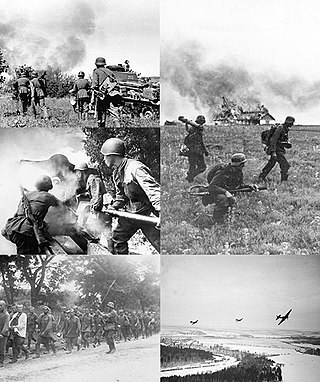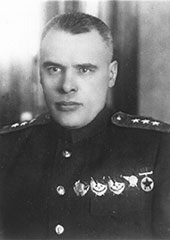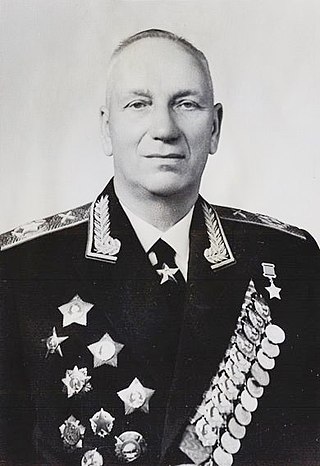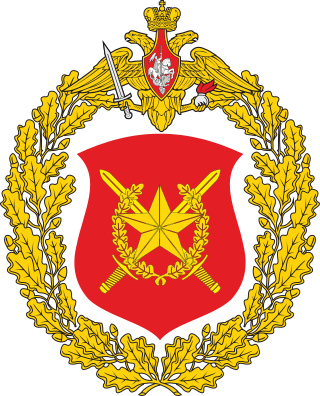
Operation Barbarossa was the invasion of the Soviet Union by Nazi Germany and many of its Axis allies, starting on Sunday, 22 June 1941, during the Second World War. It was the largest land offensive in human history, with around 10 million combatants taking part. The operation, code-named after Frederick Barbarossa, a 12th-century Holy Roman Emperor and Crusader, put into action Nazi Germany's ideological goal of conquering the western Soviet Union to repopulate it with Germans. The German Generalplan Ost aimed to use some of the conquered people as forced labour for the Axis war effort while acquiring the oil reserves of the Caucasus as well as the agricultural resources of various Soviet territories, including Ukraine and Byelorussia. Their ultimate goal was to create more Lebensraum for Germany, and the eventual extermination of the native Slavic peoples by mass deportation to Siberia, Germanisation, enslavement, and genocide.

The Battle of Moscow was a military campaign that consisted of two periods of strategically significant fighting on a 600 km (370 mi) sector of the Eastern Front during World War II, between September 1941 and January 1942. The Soviet defensive effort frustrated Hitler's attack on Moscow, the capital and largest city of the Soviet Union. Moscow was one of the primary military and political objectives for Axis forces in their invasion of the Soviet Union.

The Soviet Air Defence Forces was the air defence branch of the Soviet Armed Forces.

Fyodor Isidorovich Kuznetsov was a Colonel General and military commander in the Soviet Union.

The Western Front was a front of the Red Army, one of the Red Army Fronts during World War II.

Nikolay Nikolayevich Voronov was a Soviet military leader, chief marshal of the artillery (1944), and Hero of the Soviet Union. He was commander of artillery forces of the Red Army from 1941 until 1950. Voronov commanded the Soviet artillery during the Battle of Stalingrad and was the Stavka representative to various fronts during the Siege of Leningrad and the Battle of Kursk. He also fought in the Russian Civil War, the Polish-Soviet War and the Battle of Khalkin Gol, as well as serving as an advisor to the Spanish Republican Army during the Spanish Civil War.
The 110th Rifle Division was a formation of the Soviet Union's Red Army during the course of World War II, which was formed, dissolved, and re-formed three times throughout the war.

The 2nd Guards M. I. Kalinin Taman Motor Rifle Division, commonly known as the Tamanians or Taman Division, is a Guards mechanised infantry division of the Russian Ground Forces. Its Military Unit Number is 23626.

The Byelorussian Military District was a military district of the Soviet Armed Forces. Originally formed just before World War I as the Minsk Military District out of the remnants of the Vilno Military District and the Warsaw Military District, it was headed by the Russian General Eugen Alexander Ernst Rausch von Traubenberg.
A Sapper Army was a multi-brigade military construction engineer formation of the Engineer Troops of the Soviet Red Army during World War II. Formed to construct large-scale defensive works, sapper armies were used from late 1941 until mid-1942 when the Red Army opted to organize smaller and more flexible construction engineer formations. Although the organization of military construction engineers into an army-level echelon was unusual, the use of dedicated troops for military construction was common to many armies of World War II.
The 270th Rifle Division was a Red Army infantry division formed twice during World War II, in 1941 and 1942.
The Red Army's 33rd Army was a Soviet field army during the Second World War. It was disbanded by being redesignated HQ Smolensk Military District in 1945.
The following lists events that happened during 1941 in the Union of Soviet Socialist Republics.
The 8th Rifle Division was a military formation of the Soviet Union's Red Army in the Winter War, the Soviet invasion of Poland, and World War II. It was formed three times.
The 13th Rifle Division was a military formation of the Red Army from 1922 to 1945. serving in World War II. It was disbanded after being defeated in 1941 and reformed from a Leningrad people's militia division later that year.

The Moscow Defence Zone was a front of the Red Army during World War II, to defend Moscow from the German advance. It was set up on 2 December 1941 to manage the troops of 24th and 60th Armies and part of the anti-aircraft defences.
The 77th Guards Rifle Division was an infantry division of the Soviet Union's Red Army during World War II.
The 274th Rifle Division was an infantry division of the Soviet Union's Red Army during World War II, formed twice.
The 267th Rifle Division was an infantry division of the Soviet Union's Red Army during World War II.
The 264th Rifle Division was an infantry division of the Soviet Union's Red Army during World War II, formed three times.
This page is based on this
Wikipedia article Text is available under the
CC BY-SA 4.0 license; additional terms may apply.
Images, videos and audio are available under their respective licenses.








